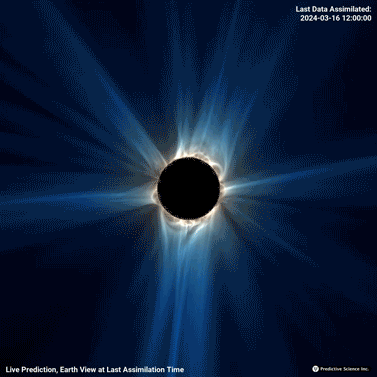News
Predictive Science Inc. Advances Dynamic Solar Corona Modeling
Published September 30, 2025
By Grace Zhao and Kimberly Mann Bruch

This simulation highlights the inherent complexity of the Sun's magnetic field and its intimate connection to visible emission from the solar corona. Credit: Predictive Science Inc.
Scientists with Predictive Science Inc. (PSI), a San Diego-based company, recently published details regarding their advanced solar corona computer model in Science. The team used the Expanse system at the San Diego Supercomputer Center (SDSC), part of the School of Computing, Information and Data Sciences (SCIDS) at University of California San Diego, to create a near-real-time model that accurately depicts the dynamic nature of the sun's outermost atmospheric layer.
“Unlike previous models that offer a time-stationary approximation gathered over a 27-day solar rotation, our approach continuously evolved by assimilating photospheric magnetic field observations as they become available,” said Cooper Downs, a research scientist at PSI. “This allowed us to reproduce dynamic features, such as thermal non-equilibrium and coronal mass ejections, that do not appear in time-stationary representations.”
Downs emphasized that their data-assimilative time-evolving calculation, which was based on data collected during the April 8, 2024 solar eclipse, highlights a new frontier in coronal and heliospheric modeling. With every snapshot of the model being dynamically connected to the previous state, it is now possible to study how magnetic changes at the Sun’s surface lead to continuous dynamics and energy storage in the corona and inner heliosphere. This has important implications for our physical understanding of how the sun influences near-Earth space environment, and can provide essential context for the next generation of coronal and heliospheric imaging observations, such as those made by the recently launched NASA PUNCH and ESA Proba-3 satellite constellations.
“This specific total solar eclipse provided an amazing laboratory for our model," said Jon Linker, PSI president and research scientist. "The sun was highly active, presenting a complex and rapidly changing corona and our observation was truly validating: our dynamic model was continuously fed with fresh magnetic field data and produced predictions that aligned much better with the actual eclipse observations.”
Linker explained that the instantaneous ability of the model to reproduce dynamic features, such as Coronal Mass Ejections (CMEs) as they occur, is crucial for helping us predict space weather more accurately. This can then help prevent disruptions to space technology and provide scientists with a deeper understanding of the sun.
Computational work on Expanse was provided by the U.S. National Science Foundation ACCESS program (allocation no. PHY240234).

